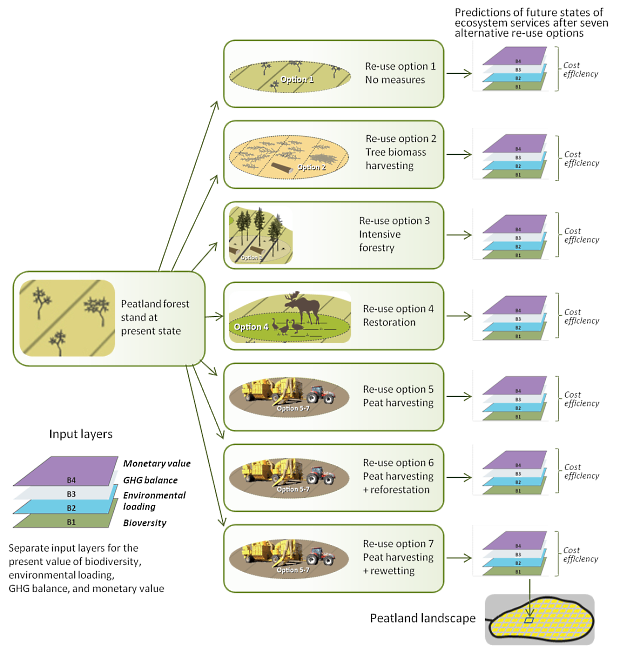LIFEPeatLandUse: Quantification and valuation of ecosystem services to optimize sustainable re-use for low-productive drained peatlands (LIFE12 ENV/FI/000150)
Implementation actions
LIFEPeatLandUse will be put into practice in six implementation actions, which are described in more detail below.
B1 Biodiversity
This Action compiles several large and long-term biodiversity datasets and models. Plant data (e.g. threatened plant species and species richness) will be used because they have considered to describe well the overall biodiversity.
B2 Environmental loading to water cources'
Peatlands have an important role in catchment hydrology with respect to water quality, water storage, the support of groundwater levels and flood and drought mitigation. Large-scale drainage has also increased significantly the environmental loading i.e. leaching of nutrients, suspended solids and organic matter from peatlands to downstream watercourses and widely weakened the state of these water bodies. The objective of this Action is to produce information on the impacts of different re-use options on a crucial ecosystem service related to peatland hydrology; the environmental loading into water courses. The main objective is to quantify the state of environmental loading at the present state, and to predict the impact of the seven re-use options (listed in Action A1) up to 100 years. The Action will generate information on the current state of environmental loading and predictions in numeric and spatial format to be used in Actions B4-B6.
B3 GHG balances
However, little information exists so far about the GHG balances of low-productive drained peatlands. It is therefore not known, what would be the best option to manage these peatlands to mitigate climate change. Without knowledge produced in this project policymakers and landowners may carry out actions with insufficient information on climate impacts. Impact of the decision may therefore conflict with EU climate goals and the objectives of Kyoto Protocol. The objective of this Action is to increase information on the effects of different re-use options on the GHG emissions from low-productive drained peatlands. The main objective is to quantify the GHG balance at the present state, and to predict the impact of seven re-use options on the GHG balance up to 100 years. This action feeds the Actions B4 and B5 by providing the GHG balance data in numeric format and the Action B6 by providing the GHG data in spatial format.
B4 Cost efficiency
The aim of this Action is to produce information on the cost-effectiveness of different re-use options so that it is possible to find combination of re-use options, which accomplishes both appointed ecological effects and economic benefits. To do this, the Action develops an integrated model in which the goal is to maximize the net present value of the proposed land area subject to given ecological constraints i.e. biodiversity (B1), environmental loading (B3) and GHG balance (B4), by numeric optimization, and tests it by producing re-use recommendations for the peatland landscapes selected in the Action A1. Monetary values of different re-use options are integrated to their environmental impacts, which makes it possible to evaluate, which re-use options produce the best results within the framework of appointed environmental targets. The results of this action are further used in the Actions B5 and B6.
B5 Decision Analysis
MESTA tool is tested and demonstrated to allocate peat harvesting sites in Northern Ostrobothnia in the project sub-area. Thus, the decision analysis process carried out in this Action constructs a link between the results of the earlier Actions (B1-B4) and practical implementation of the re-use options of drained peatlands. The results of this Action, i.e. the MESTA tool and related participatory process provide thus good preconditions to create a new kind of regional peat harvesting site selection process.
B6 Map presentations and demonstrations
Web-based demonstrations can be used to visualize the location of low-productive drained peatlands, as well as to evaluate the sustainability of different re-use options to the ecological and economical points of view. The objective of this Action is to summarize project results (B1-B4) by visual demonstrations on peatland ecosystem services and the impacts of peatland re-use options on them. This makes it possible to identify, for example, the biodiversity, water quality, GHG fluxes and monetary value for any given location in the project area. In addition, it is possible to observe how people value the importance of the region.

Project area map (pdf)

